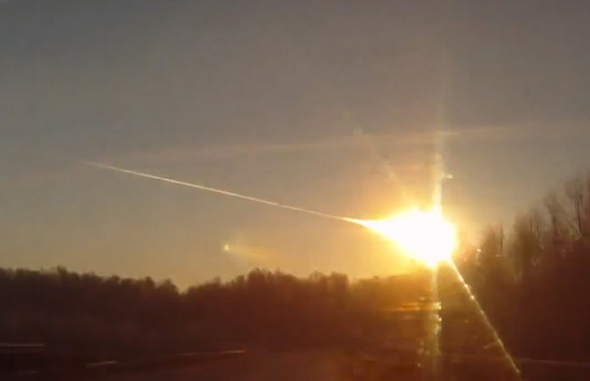
2012 TC4 is an asteroid measuring 20 meters in diameter. The house sized space rock was discovered on October 4, 2012 by the Pan-STARRS observatory in Hawaii at a distance of 0.03 AU (4,500,000 km; 2,800,000 mi) from Earth shining at magnitude 20.1 during a short 7 day observable window. It was then re-discovered by Very Large Telescope (VLT) on 17 July 2017 at an exceptionally dim apparent magnitude of 26.8. This makes it the first asteroid ever to be observed passing less than 1 lunar distance to the Earth on two occasions. The asteroid has an orbital period of 1.67 years and is given a rating of -3.66 on the Palermo scale, with a 1 in 630 chance of an Earth impact over the next hundred years.
This asteroid is of similar size to the Meteor that exploded high over the skies of Chelyabinsk, Russia on 15 February 2013 (imaged above). The main difference with asteroid 2012 TC4 being that we know this asteroid is coming unlike the event that unfolded at Chelyabinsk.
Possible Impact?
2012 TC4 is expected to reach closest approach to the Earth on Thursday, 12 October 2017 at a nail-bitingly close distance of around 27,300 miles. That is within the thermosphere and just outside the orbit of geostationary satellites. Thankfully, astronomers are confident that the asteroid will pass the Earth harmlessly and there is no cause for alarm. Detlef Koschny of ESA’s near-Earth objects research team said, “We know for sure that there is no possibility for this object to hit the Earth”. Likewise, Makoto Yoshikawa of the Japanese Aerospace Exploration Agency (JAXA) has said, “The distance is very small. But this distance does not mean the collision”.
Györgyey-Ries of the University of Texas says,
Although it has a large uncertainty along the orbit, it is much less than the radial uncertainty, so it just changes the time of the closest flyby. I would say based on this, that there is no chance of impact in 2017, but more observations could help to reduce the uncertainties.
Although the Earth’s safety is fairly certain for this pass, Earth’s gravity will significantly alter the asteroid’s trajectory before it exits the Earth-Moon system. Space agencies will no doubt be keeping a keen eye on the orbit of Asteroid 2012 TC4 for some time to come.
An Opportunity
This “asteroid flyby” or close approach for the use of a better phrase will provide an opportunity for professional astronomers to test their detection and tracking abilities of near Earth objects (or NEO’s). The object’s brightness is expected to peak at magnitude 12.9 at closest approach so it will also become observable to keen amateur astronomers alike.
Potentially Hazardous Asteroids
Potentially Hazardous Asteroids (PHA’s) are defined based on parameters that measure the asteroid’s potential to make threatening close approaches to the Earth. The International Astronomical Union’s Minor Planet Centre keeps a central catalogue of all known PHA’s. As of 10 September, 2017 there are currently 1803 PHA’s, none of which are known to to be on a collision course with Earth. NASA’s Planetary Defence section has an interesting frequently asked questions page all about Near Earth Asteroid detection, tracking and defence.
The Asteroid is expected to peak at around magnitude 12.8 and will reach closest approach at 05:42 UT on Thursday, 12 October 2017. A live webcast will also be available.

Leave a Reply